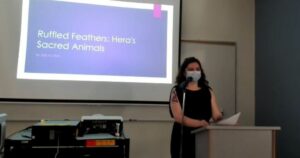What do Batman, the Greek monster Argos, and a fictional flesh-eating virus have in common?
They were all the subjects of some frightfully wellresearched presentations at UWM’s Beastly Conference in May.
The Beastly Conference is becoming an annual tradition in UWM’s Honors College. Now in its third year, the small symposium invites humanities student researchers to pick their own topics centering on a beastly theme and present their work for their peers and teachers.
‘Beastly’ is open to interpretation.
“We were drawn to questioning what really makes a human a human,” said Jessica Plotkin, the student responsible for organizing this year’s conference. “What’s the dividing line between humans and animals?”
Plotkin, who graduated in May, was a pre-med student who majored in Classics (“I have always loved ancient Greek culture. I’m never going to have a chance to do this as a doctor, so as an undergraduate I decided to go all in on ancient Greek stuff,” she explained.) She was also a co-founder and leader of HARPY, a student research group that hosts both the Beastly Conference and its complementary Monster Conference in the fall.
HARPY stands for the Honors Association for Research and Publication. The group added the Y as a nod to the Greek mythological harpies, half-bird and half-women creatures who steal food and torment the wicked. The group is meant to facilitate student research in the Honors College.
While UWM’s Office of Undergraduate Research does a great job of connecting students with faculty research projects, “There is still a gap for people who want to do humanities-based research because there aren’t labs like there are for the hard sciences,” Plotkin said. “We wanted to create a student-directed, humanities-based research organization. So, we did.”
Under the guidance of faculty advisor Jacqueline Stuhmiller, HARPY founded the Monster and Beastly conferences three years ago. Organizing this event is a months-long undertaking, and one shouldered almost solely by Plotkin herself, since her fellow HARPY officer was studying abroad this semester. Plotkin put out a call for papers in January and talked with her classmates to encourage them to submit abstracts. When she had a spate of potential presenters, she worked with several to help them develop their research ideas from vague outlines into actual presentations.
“It was a phenomenal experience to see them go from confusing abstracts where they’re just throwing out ideas and seeing what sticks, to being these really coherent, strong presenters who have gained confidence in their abilities,” Plotkin said with pride.
For example, there was Cameron Ahles, a mechanical engineering major who started the conference with a thoughtful look into the superhero Batman. Ahles used the DC Comic character to highlight how humans routinely borrow animal qualities to better understand our own humanity. For example, we use a ‘Birds and Bees’ talk to teach children about sex and reproduction.
“Alas, we are ashamed of, and petrified by, our primal, animalistic nature. Bruce (Wayne, Batman’s secret identity) is too, but when he dons the mask, he finds more of himself than ever before,” Ahles observed.
“The Batman shows the power of our access through our beastly instincts. Batman is the hero we need to guide us through the darkness: The darkness around us and the darkness in ourselves.”
Then there was Danny Muntz, a first-year student who introduced his audience to the SPC Foundation. It’s an online creative writing forum focusing on fictional anomalies, like a flesh-eating disease that slowly erases its victims’ human features and personalities. Muntz posited that a person’s individuality – their hopes, fears, likes, dislikes, tastes, and more – is what makes them who they are. But, he added, through disease, death, or even dementia, “We can lose what makes us human. We can become beasts.”
For her presentation, Plotkin, of course, turned to mythology, explaining misconceptions surrounding a popular myth: Zeus, fearful of his wife Hera’s wrath, turns his lover Io into a cow. The suspicious Hera sets her many-eyed monster, Argos, to guard the cow, and Zeus kills the monster to free his lover. Hera, mourning the death of Argos, sets his many eyes on the tail feathers of a peacock.
But, Plotkin said, there’s more to this myth. The popular version that most people are familiar with today was penned by Ovid and portrays Hera as a scheming, jealous woman. However, in ancient Greece, Hera was revered and respected. Earlier versions of the myth claim that Io was the high priestess of Hera’s temple when Zeus assaulted the unlucky woman and later changed her into a bovine. Argos was not a monster but instead a mortal, gifted extra eyes by Hera, who was sent to protect Io. And finally, Hera’s favorite animal was never the peacock, Plotkin argued – her favorite animals were always humans.
The conference was held in person and also streamed live over Zoom. Plotkin was delighted with its success.
“These students are phenomenal,” she said. “They put in such incredible work every semester, and this semester’s crop was especially impressive. So, I recommend that you keep an eye out for HARPY in the future.”
